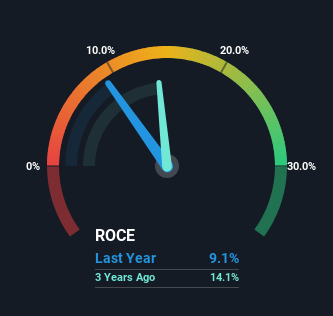Some Investors May Be Worried About Atrion's (NASDAQ:ATRI) Returns On Capital
Ignoring the stock price of a company, what are the underlying trends that tell us a business is past the growth phase? A business that's potentially in decline often shows two trends, a return on capital employed (ROCE) that's declining, and a base of capital employed that's also declining. This indicates the company is producing less profit from its investments and its total assets are decreasing. In light of that, from a first glance at Atrion (NASDAQ:ATRI), we've spotted some signs that it could be struggling, so let's investigate.
Return On Capital Employed (ROCE): What Is It?
For those that aren't sure what ROCE is, it measures the amount of pre-tax profits a company can generate from the capital employed in its business. To calculate this metric for Atrion, this is the formula:
Return on Capital Employed = Earnings Before Interest and Tax (EBIT) ÷ (Total Assets - Current Liabilities)
0.091 = US$23m ÷ (US$261m - US$13m) (Based on the trailing twelve months to December 2023).
Therefore, Atrion has an ROCE of 9.1%. On its own that's a low return on capital but it's in line with the industry's average returns of 9.4%.
View our latest analysis for Atrion
While the past is not representative of the future, it can be helpful to know how a company has performed historically, which is why we have this chart above. If you want to delve into the historical earnings , check out these free graphs detailing revenue and cash flow performance of Atrion.
How Are Returns Trending?
There is reason to be cautious about Atrion, given the returns are trending downwards. Unfortunately the returns on capital have diminished from the 19% that they were earning five years ago. And on the capital employed front, the business is utilizing roughly the same amount of capital as it was back then. This combination can be indicative of a mature business that still has areas to deploy capital, but the returns received aren't as high due potentially to new competition or smaller margins. If these trends continue, we wouldn't expect Atrion to turn into a multi-bagger.
In Conclusion...
In summary, it's unfortunate that Atrion is generating lower returns from the same amount of capital. Long term shareholders who've owned the stock over the last five years have experienced a 48% depreciation in their investment, so it appears the market might not like these trends either. With underlying trends that aren't great in these areas, we'd consider looking elsewhere.
One more thing: We've identified 3 warning signs with Atrion (at least 1 which shouldn't be ignored) , and understanding them would certainly be useful.
While Atrion isn't earning the highest return, check out this free list of companies that are earning high returns on equity with solid balance sheets.
Have feedback on this article? Concerned about the content? Get in touch with us directly. Alternatively, email editorial-team (at) simplywallst.com.
This article by Simply Wall St is general in nature. We provide commentary based on historical data and analyst forecasts only using an unbiased methodology and our articles are not intended to be financial advice. It does not constitute a recommendation to buy or sell any stock, and does not take account of your objectives, or your financial situation. We aim to bring you long-term focused analysis driven by fundamental data. Note that our analysis may not factor in the latest price-sensitive company announcements or qualitative material. Simply Wall St has no position in any stocks mentioned.

